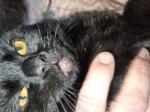Cat Care Essentials
Cat care, in the most general sense, is rather basic:
- Food
- Clean water
- Shelter, and
- Proper medical care.
These are the obvious needs of any pet. Beyond those obvious needs are other elements to pet care, such as:
- Love and attention
- Proper socialization
- Play time and exercise, and
- Undisturbed rest.
But, as they say, the devil is in the details, no?
Let's look at some of the ins and outs of basic cat care, otherwise known as "the care and feeding of the domestic cat."
Cat Food: Feeding Time
Cats are built for speed and agility. Watch a few minutes of any television show about cats and you can easily see that cats were made to hunt, kill, and eat in a short time span. Hunting is tiring work, though, so then comes time to sleep it off.
They sleep to conserve energy and rebuild their bodies for the next hunt. In a house cat's life, all that sleep readies them for crazy play time where they burn an enormous amount of energy. If they were in the wild, they'd be hunting prey and eating it as their cousins do.
All of this means that your cat needs to be fed large amounts of protein regularly in order to keep healthy.
Cats are "obligate carnivores" and require a certain balance of protein or they may become malnourished, blind, or develop other ailments and even behavior problems.
Attempting to turn your cat into a vegetarian won't do her any favors. There's no vegan lifestyle for cats.
Likewise feeding your kitty dog food or anything else but a premium cat food will not help her. Pet owners have made their cats sick doing exactly that, sometimes with permanent consequences.
For kittens 6 months and younger, kitten food has everything a growing cat needs. They should be fed 3 to 4 times daily.
Kitten food is highly concentrated nutrition, so much so that many vets recommend feeding a pregnant cat kitten food so that she can more easily "eat for 6" or so.
Cats older than 6 months should be fed a premium adult cat food at least twice a day, or you can feed dry food and allow "free choice."
Cats will typically not gorge themselves like dogs. They usually just eat what they need to eat, and leave the rest for later.
This is true in multi-cat households as well. A well adjusted cat will share its food, perhaps a bit reluctantly at times, with house mates and not overeat.
I have always used free choice and except in the case of one "fatso" who shall remain nameless, it has worked fine for all three of my cats. "Fatso" is not so fat anymore thanks to increasing her exercise level.
Whenever you change cat food, whether it be brand or type, you should always transition slowly. There is no hard and fast rule, but you can start by mixing in roughly 20% new, 80% old, then go to 50/50, then 80/20, then 100% new over several days to a week.
You should move your cat from kitten food to adult cat food in the same way. This will help to avoid any intestinal disturbance or nutritional deficiencies.
The bottom line? Cat care includes regularly feeding your cat a premium cat food, and ensuring that fresh clean water is always available.
Join us as we go in search of the best cat food.
The Importance of Fresh Water
Cats can become dehydrated due to illness, excessive vomiting, or if they don't get enough water to drink. Dehydration is a life threatening condition. Fresh water must always be made available to your cat.
My cats always get filtered water, and yes, they are spoiled. Your cat does not need to drink milk, nor is it good for them!
In fact, many adult cats are lactose intolerant. Fresh water should be the only thing your cat drinks.
Some vets and feline health experts are concerned that many cats are in a state of chronic dehydration. Here are some ways to prevent that:
- Get a cat drinking fountain.
- Due to its high water content, feed a premium canned wet food.
Feeding food with high moisture content usually encourages your cat to eat a bit less as well, as your cat gets more nutrition from less volume of food.
Grooming and that Darn Fur
Cats spend much of their waking hours grooming themselves. They bathe themselves with their barbed tongues and have no choice but to send hair down their throats and into their stomachs.
This leads to a collection of hair in the gut known as a hairball or furball. It's not their fault, if you had all that hair and a barbed tongue, it would happen to you too.
Hairballs in cats are an extremely common cat care issue. In addition to the regurgitated fur cigars cat owners find on the floor, hairballs can pose a health risk to cats.
Feline constipation, excessive vomiting, and in some cases more serious conditions such as megacolon or intestinal blockage can occur. Some of these conditions require surgery or other medical treatments.
The main thing you can do to reduce the risk of hairballs, or lessen their severity, is groom your cat on a regular basis. Since cats normally do not need a bath, the primary grooming activity is brushing or combing your cat's hair (although bathing may be useful as well).
Doing this regularly will assist your cat in removing the excess hair that would normally form hairballs. Most cats will enjoy a short grooming session several times a day, especially if you get them used to it when they are kittens.
For long or medium-haired cats a wide-toothed comb is recommended. For shorter haired cats, a slicker brush will work as the wide-toothed comb won't get a good grip on the hair. Depending upon the breed, amount and length of hair, daily or weekly grooming is recommended.
You can get grooming mitts as well in place of a comb or brush. Instead, what I have used is gardening gloves with the rubber dots on the palms. It works great to pull up the hair, and my cats like the attention too.
As part of your cat care regimen, you might want to periodically check for fleas when you are grooming your cat. Here's how... take a wet paper towel, and rub the hair filled comb or brush over it. If you see reddish-brown dots on the paper towel, your cat has fleas, and so does your house!
Nail care is also important. See this visitor contributed tip on how to trim cat claws. If your cat is the nervous type, you may find this page on reducing anxiety in cats with clipnosis interesting.
Here are the essential cat grooming tools. Once you have your tools, it's time to use them. Use them regularly and often, and you'll make both you and your cat happy.
Lower vet bills for you, lower carpet and upholstery cleaning bills for you, fewer intestinal upsets for your cat, and a beautiful, shiny coat for her to show off, and you to admire.
Learn tips and techniques from these Expert Village videos on how to groom a cat.
Living Environment
General cat care requires that you provide a safe and cat friendly environment for your cat to live in. This includes proper sleeping areas, cat toys (even if they're homemade toys) to play with, clean cat boxes, and adequate temperature and ventilation.
Providing a cat safe environment means arranging your home so that you remove any obvious dangers. You should ensure that you remove any plants that are poisonous to cats from your home.
Here's a poison plant list from the ASPCA.
Adequate litter box care is necessary to prevent cat litter box problems. A major part of cat care is providing the right litter box environment. Anything that throws a cat off from the normal box routine can cause a chain of events resulting in inappropriate elimination.
Start your new cat off right by providing the right environment for litter box training. Setting up a cat sanctuary in your home is an excellent way to ensure that your cat will have everything needed for exercise, protection, play, and rest.
The "indoor cat versus the outdoor cat" is an argument that will probably never find a resolution. All major cat care organizations that I have researched recommend that you keep your cat indoors.
The reasons are fairly obvious. It's far safer, your cat will live longer, be less subject to injury and disease, and you won't have to worry about whether your cat is safe or not.
People who argue for outdoor cats will often cite either complaints about having a cat indoors, or that it is some how better for the cat to be outside.
Most of the complaints about indoor cats can either be remedied, or are relatively minor. Spraying, inappropriately defecating, and cat fur on the furniture are a possible part of life with a cat at some point.
On a grand scale, cats didn't choose to be domesticated and bred. On a personal level, if you choose to keep a cat as a pet, along with that comes the burden of cat care. If you're not willing to deal with it, then you shouldn't have a pet.
As for cats being better off outside, well, they adapt just fine to living indoors. Outdoor cats, on the other hand, have a greater risk of injury when outside. Unfortunately, car accidents, poisonous materials, and fights with other cats are all part of life outside for a domestic cat. In my area, raccoons and other predatory or diseased animals are a common threat.
People can be quite a danger to your cat as well. Go to some of the gardening web sites that have forums and view the discussions. You'll see how many angry gardeners out there try to poison cats who come into the their yards.
It's quite sad, but every year at Halloween, hundreds of cats are tortured at the hands of humans. Don't let your cat end up as someone's experiment. Shelters in the US will sometimes not allow adoption of black cats during October because of this problem.
Indoor cats have been known to live over three times longer than outdoor cats... choose wisely.
Cat Health Care
A major part of cat care is maintaining your cat's health. This especially true as your cat ages.
Whether kitten or senior cat, it is your responsibility as a cat owner to ensure that your cat gets regular check ups by a qualified veterinarian. A newly acquired cat of any age should be taken to the vet immediately, and before introducing it to any other cats you might have in the house.
Your vet will instruct you on the proper vaccination schedule for your new cat. In addition, healthy cats should receive a once per year visit (the AVMA now recommends twice annual visits) to the vet for a standard check up and repeat vaccinations. Do not neglect this vital cat care task.
Observing your cat's behavior and learning to recognize the major cat illness symptoms is a big part of cat care as well. Observe your cat's eating, sleeping, bathroom, and play habits and take notice of any changes.
One of my cats decided to sleep in one chair all day, and I didn't notice. The next day, I realized she was sick and took her to the vet. She was fine in the end (after receiving treatment), but I should have known something was wrong. Make sure you familiarize yourself with these signs of cat illness.
Cat care is more than just bringing a cat into your house, it's bringing your cat into your life. Treat your little one as you would any member of your family and show her lots of care.
What Are Your Top Cat Care Tips?
Do you have some great cat care tips that have worked for you? Something that will make another cat owner's life easier? A tip that will enhance the life of a cat or cat owner? Share it!
More on Cat Care
More than 20 Cat Care Tips
Here I've outlined more than 20 cat care tips in various areas. These tips will make life better for both you and your feline friend.
Tips on caring for your senior cat
Senior cats will slow down a bit, but still need playtime. In addition, they may need assistance with grooming.
How to get a cat into a carrier
At some point in time, we have to get the cat in the car and go for a ride. For most of us, it's not easy. There is a better way.



Comments: What do you think?
Have your say about what you just read. Leave me a comment in the box below.